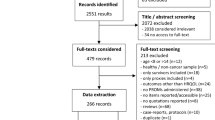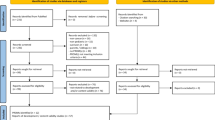Abstract
Purpose
The impact of cancer on children can be assessed through various concepts including mental and physical health status and most significantly quality of life (QOL). It has been difficult to compare data collected through these instruments due to a lack of continuity or understanding of overlaps and gaps between them. To delineate the content of the most commonly used instruments in childhood cancer on an item-by-item basis, this study used standardized methods to link health information to the International Classification of Functioning, Disability, and Health (ICF) as well as World Health Organization (WHO) standard definitions of health and quality of life.
Method
MEDLINE, CINAHL, EMBASE, PsycINFO, Cancerlit, and Sociological Abstracts were searched from the inception of each database to June 15th, 2009 for health status and quality of life instruments. The six most common cancer-specific and generic instruments employed in primary research in childhood cancer were analyzed on an item-by-item basis by two content assessors specializing in ICF linking and WHO definitions of health and QOL, using a standardized iterative technique developed at the ICF Research Branch.
Results
We report the extent to which health status and QOL are represented in each instrument. Most measures emphasize a majority health status perspective according to WHO definitions of health. The generic instruments stress activities and participation domains over body functions or environment factors according to the ICF while cancer-specific instruments vary in their emphasis. Initial phase of coding agreement between assessors was in the substantial range (0.6–0.8 using Cohen’s kappa).
Conclusion
A comprehensive and systematic content analysis of the most commonly employed health status and QOL instruments was conducted for this review. Two criteria were described as follows: the perspectives of the instruments (i.e., health vs. QOL) and the health content (according to ICF components). No single instrument demonstrated an ideal balance of content characteristics according to these criteria, and thus, each must be considered carefully relative to one’s particular research or clinical evaluative purpose.


Similar content being viewed by others
References
Ries, L. A. G., Kosary, C. L., Hankey, B. F., Miller, B. A., Clegg, L., & Edwards, B. K. (1998). SEER cancer statistics review. Resource document. National cancer institute. http://www-seer.ims.nci.nih.gov. Accessed 11 Dec 2009.
Canadian Cancer Society and National Cancer Institute of Canada. (2008). Canadian cancer statistics. Resource document. www.cancer.ca/statistics and www.ncic.cancer.ca. Accessed 27 Jan 2010.
Langeveld, N. E., Stam, H., Grootenhuis, M. A., & Last, B. F. (2002). Quality of life in young adult survivors of childhood cancer. Supportive Care in Cancer, 10, 579–600.
Hinds, P. S. (1990). Quality of life in children and adolescents with cancer. Seminars in Oncology Nursing, 6(4), 285–291.
Hinds, P. S., Gattuso, J. S., Fletcher, A., Baker, E., Coleman, B., Jackson, T., et al. (2004). Quality of life as conveyed by paediatric patients with cancer. Quality of Life Research, 13(4), 761–772.
Wilson, I. B., & Cleary, P. D. (1995). Linking clinical variables with health-related quality of life. JAMA, 273(1), 59–65.
LePlege, A., & Hunt, S. (1997). The problem of quality of life in medicine. JAMA, 278, 47–50.
McGrath, C., Rofail, D., Gargon, E., & Abetz, L. (2010). Using qualitative methods to inform the trade-off between content validity and consistency in utility assessment: the example of type 2 diabetes and Alzheimer’s disease. Health and Quality of Life Outcomes, 8, 23–27.
Bradley, C. (2001). Importance of differentiating health status from quality of life. Lancet, 357, 7–8.
World Health Organization. (2005). International classification of functioning disability and health: Children and youth. Geneva: WHO.
World Health Organization. (1998). WHOQOL user manual. Geneva: WHO.
Norman, G. R., & Streiner, D. L. (2008). Health measurement scales: A practical guide to their development and use (4th ed.). Oxford: Oxford University Press.
Hobart, J. C., Cano, S. J., Zajicek, J. P., & Thompson, A. J. (2007). Rating scales as outcome measures for clinical trials in neurology: Problems, solutions, and recommendations. Lancet Neurology, 6, 1094–1105.
Fayed, N., Bickenbach, J. E. & Cieza, A. (2011). Linking health and health-related information to the ICF: A systematic review of the literature from 2001 to 2008. Disability and Rehabilitation (accepted).
Cieza, A., Brockow, T., Ewert, T., Amman, E., Kollerits, B., Chatterji, S., et al. (2002). Linking health-status measurements to the international classification of functioning, disability and health. Journal of Rehabilitation Medicine, 34(5), 205–210.
Cieza, A., Geyh, S., Chatterji, S., Kostanjsek, N., Ustun, B., & Stucki, G. (2005). ICF linking rules: An update based on lessons learned. Journal of Rehabilitation Medicine, 37(4), 212–218.
Fayed, N., & Kerr, E. (2009). Comparing quality of life scales in childhood epilepsy: What’s in the measures? International Journal of Disability and Community Rehabilitation, 8(3), 1–11.
Waters, E., Davis, E., Ronen, G., Rosenbaum, P., Livingston, M., & Saigal, S. (2009). Quality of life instruments for children and adolescents with neurodisabilities: How to choose the appropriate instrument. Developmental Medicine and Child Neurology, 51, 660–669.
Clarke, S. A., & Eiser, C. (2004). The measurement of health-related quality of life in paediatric clinical trials: A systematic review. Health and Quality of Life Outcomes, 2(1), 66.
Davis, E., Waters, E., Mackinnon, A., Reddihough, D., Kerr-Graham, H., Mehmet-Radji, O., et al. (2006). Paediatric quality of life instruments: A review of the impact of the conceptual framework on outcomes. Developmental Medicine and Child Neurology, 48(4), 311–318.
De Civita, M., Regier-Evaluat, D., Alamgir, A. H., Aslam, A. H., Fitzgerald, M. J., & Marra, C. A. (2005). Evaluating health-related quality of life studies in paediatric populations: Some conceptual, methodological and developmental considerations and recent applications. Pharmacoeconomics, 23(7), 659–685.
Eiser, C., & Morse, R. (2001). A review of measures of quality of life for children with chronic illness. Archives of the Disabled Child, 84, 205–211.
Harding, L. (2001). Children’s quality of life assessments: A review of generic and health related quality of life measures completed by children and adolescents. Clinical Psycholology & Psychotherapy, 8, 79–96.
Rajmil, L., Herdman, M., Fernandez de Sanmamed, M. J., Detmar, S., Bruil, J., Ravens-Sieberer, U., et al. (2004). Generic health-related quality of life instruments in children and adolescents: A qualitative analysis of content. Journal of Adolescent Health, 34(1), 37–45.
Ravens-Sieberer, U., Erhart, M., & Wille, N. (2006). Generic health-related quality of life assessment in children and adolescents: Methodological considerations. Pharmacoeconomics, 24(12), 1199–1220.
Matza, L. S., Swensen, A. R., Flood, E. M., et al. (2004). Assessment of health-related quality of life in children: A review of conceptual, methodological, and regulatory issues. Value in Health, 7, 79–92.
Solans, M., Pane, S., Estrada, M. D., Serra-Sutton, V., Berra, B., Herdman, M., et al. (2008). Health-related quality of life measurement in children and adolescents: A systematic review of generic and disease-specific instruments. Value in Health, 11(4), 742–764.
Klassen, A. F., Strohm, S. J., Maurice-Stam, H., & Grootenhuis, M. (2009). Quality of life questionnaires for children and childhood cancer survivors: A comparison of available measures. Supportive Care in Cancer, 18(9), 1207–1217.
Pickard, A. S., Topfer, L., & Feeney, D. H. (2004). A structured review of studies of health-related quality of life and economic evaluation in paediatric acute lymphoblastic leukemia. Journal of Natl Cancer Inst Monographs, 33, 102–124.
Landgraf, J. M., Abetz, L., & Ware, J. E. (1996). Child health questionnaire (CHQ): A user’s manual. Boston: The Health Institute, New England Medical.
Varni, J. W., Seid, M., & Rhode, C. A. (1999). The PedsQL™: Measurement model for the paediatric quality of life inventory. Medical Care, 37(2), 126–139.
Varni, J. W., Seid, M., & Kurtin, P. S. (2001). PedsQL 4.0™: Reliability and validity of the paediatric quality of life inventory version 4.0™ generic core scales in healthy and patient population. Medical Care, 39(8), 800–812.
Furlong, W., Boyle, M., & Torrance, G. W. (1995). Multi-attribute health status classification systems. Health utilities index. Pharmacoeconomics, 7(6), 490–502.
Feeny, D. H., Torrance, G., & Furlong, W. (1996). In B. Spilker (Ed.), Health Utilities Index in quality of life and pharmacoeconomics in clinical trials, 2nd ed. Philadelphia: Lippincott-Raven.
Bhatia, S., Jenney, M. E. M., Bogue, M. K., Rockwood, T. H., Feusner, J. H., Friedman, D. L., et al. (2002). The minneapolis-manchester quality of life instrument: Reliability and validity of the adolescent form. Journal of Clinical Oncology, 20, 4692–4698.
Bhatia, S., Jenney, M. E. M., Wu, E., Bogue, M. K., Rockwood, T. H., Feusner, J. H., et al. (2004). The Minneapolis-Manchester quality of life instrument: Reliability and validity of the youth form. Journal of Clinical Oncology, 145, 39–46.
Varni, J. W., Katz, E. R., Seid, M., Quiggin, D. J. L., Friedman-Bender, A., & Castro, C. M. (1998). The paediatric cancer quality of life inventory (PCQL): Instrument development‚ descriptive statistics‚ and cross-informant variance. Journal of Behavioral Medicine, 21(2), 179–204.
Goodwin, D. A. J., Boggs, S. R., & Graham-Pole, J. (1994). Development and validation of the paediatric oncology quality of life scale. Psychological Assessment, 6(4), 321–328.
Sandelowski, M. (2000). What ever happened to qualitative description? Research in Nursing and Health, 23, 334–340.
Grill, E., Mansmann, U., Cieza, A., & Stucki, G. (2007). Assessing observer agreement when describing and classifying functioning with the international classification of functioning, disability and health. Journal of Rehabilitation Medicine, 39(1), 71–76.
Woodgate, R. L., Degner, L. F., & Yanofsky, R. (2003). A different perspective to approaching cancer symptoms in children. Journal of Pain and Symptom Management, 26(3), 800–817.
Heritage, J. (2002). The limits of questioning: negative interrogatives and hostile question content. Journal of Pragmatics, 34(10–11), 1427–1446.
Swartz, N. (1999). How the questions shape the answers. American Psychologist, 44(2), 93–105.
van Achterberg, T., Holleman, G., Heijnen-Kaales, Y., van-der-Brug, Y., Roodbol, G., Stallinga-Hillegonda, A., et al. (2005). Using a multidisciplinary classification in nursing: The international classification of functioning disability and health. Journal of Advanced Nursing, 49(4), 432–441.
Soberg, H. L., Sandvik, L., & Ostensjo, S. (2008). Reliability and applicability of the ICF in coding problems, resources and goals of persons with multiple injuries. Disability and Rehabilitation, 30(2), 98–106.
Author information
Authors and Affiliations
Corresponding author
Additional information
An erratum to this article can be found at http://dx.doi.org/10.1007/s11136-011-9895-6
Rights and permissions
About this article
Cite this article
Fayed, N., Schiariti, V., Bostan, C. et al. Health status and QOL instruments used in childhood cancer research: deciphering conceptual content using World Health Organization definitions. Qual Life Res 20, 1247–1258 (2011). https://doi.org/10.1007/s11136-011-9851-5
Accepted:
Published:
Issue Date:
DOI: https://doi.org/10.1007/s11136-011-9851-5




